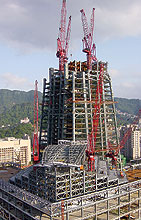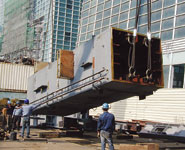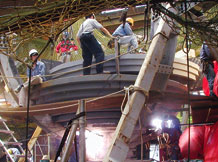
Residents of Taiwans capital may be worried about the 101-story building rising in their typhoon- and earthquake-prone city, especially in this era of heightened fears of terrorism. However, Taipeis 508-meter-tall tower, destined to grab the record from Kuala Lumpurs twin Petronas Towers when it opens late next year, is the safest place in town, says its structural designer.
"If this building is going to be damaged, other buildings in Taipei will collapse," claims Shaw Shieh, president of the towers local structural designer, Evergreen Consulting Engineering Inc.
Taipei 101s steel megacolumns are designed to keep the $700-million skyscraper standing tall under extreme conditions. But their erection has been a humbling experience, helping to delay completion by a year. "Welding was one of the most difficult aspects," says Dugald MacKay, project director with Turner International, New York City, the project manager.
 |  |
| Lower floor megacolumns slope inward with the buildings facade. (Photo courtesy of Turner International) | Eight-floor modules with outward leaning facades emerge from lower 26 floors. (Photo courtesy of Joseph Gartner & Co.) |
A March 31, 2002, earthquake was equally disruptive. In that incident, two cranes toppled, killing five workers (ENR 4/8/02 p.14).
Taipeis 200,000-sq-m tower rises from a roughly 53-m-square footprint. The four exterior walls of the lower 25 stories slope inward nearly 5°. Above that, eight stacked, dimensionally identical modules, each eight stories and with 7° outward-leaning facades, rise to level 90. Topping that are 11 mechanical equipment levels that step back three times. A 60-m-tall pinnacle, rising from the 101st story, completes the tower at 508 m. Two dampers within the pinnacle and another suspended from the 92nd level reduce wind vibrations (see p. 28). A linked, five-story podium at the base contains a shopping mall, which is now open.
|
The towers stepped profile provides 7° window slopes to enhance downward vision and reduce solar gain, according to project architect C.Y. Lee & Partners, Taipei. And it creates external fire safety decks at the base of each eight-floor module. Shelters inside these levels will have fire fighting, smoke displacement and communications equipment.
Each module is isolated by smoke and fire barriers, and contains independent security systems. Fire- and smoke-resistant safety stairways and corridors also provide security.
Over a day and a half last month, workers using strand jacks lifted the 470-tonne pinnacle to its full height from within the structure, where it had been partially built. The lift made the tower 56 m taller than Malaysias twin Petronas towers. However, "it was never the original idea to build the tallest building," says Hong-Ming Lin, president of owner Taipei Financial Center Corp.
Early plans called for a 60-story tower with a pair of 20-story blocks, one for each of two anchor tenants, says Lin. But because both tenants wanted space in the main block, the developer proposed a single 88-story tower.
"My partner C.Y. and I have always wanted to build something very tall," says C.P. Wang, C.Y. Lees vice chairman. "With the encouragement of the mayor...we [then] convinced the owner to go higher."
That decision six years ago led to trouble. After local approvals for 101 stories had been secured, the height was challenged by the local airport operator, recalls Shieh.
While waiting for that to be resolved, engineers sized the structure to accommodate the heaviest seismic and wind loads for 88 and 101 stories. The process avoided revisions later on but was one of the earliest causes of delay, says MacKay.
In selecting a structural system, Evergreen was inspired to adopt the "megacolumn" concept of Chicagos unbuilt 610-m-tall Miglin Beitler tower, designed by New York City-based Thornton-Tomasetti/Engineers. T-T joined the Taipei 101 team in 1998. Shieh says he welcomed the firms involvement. "They made us feel more confident about designing a supertall building," he says.
T-T spent "thousands of hours" contributing design criteria and preliminary drawings, says Dennis Poon, T-Ts managing principal for the job, and reviewed construction documents. It also advised on specific issues.
To provide the biggest lever arm against overturning, the structure concentrates main loads in two, generally 3 x 2.4-m vertical megacolumns, 22.5 m apart along each face, almost touching the sloping perimeter wall at its base. Main floor girders connect each megacolumn through moment connections with a core corner column along the same gridline, forming a tick-tack-toe board (see drawing, p. 26). The 22.5-m-square core comprises 16 box columns in four lines, which are generally fully braced between floors. Composite floors are typically 13.5 cm thick.
At equipment floors every eighth level, outriggers connect megacolumns and the core. Outriggers are generally formed by vertically bracing main floor girders above and below equipment floors. Further crossbracing between main perimeter columns at these levels forms belt trusses around the tower. Two minor outriggers connect the cores central columns with sloping H-shaped uprights in each modules face.
From just below level 26 down, megacolumns slope with the buildings profile. Two, 2 x 1.2-m columns are added toward the center of each facade, while each corner is supported by an additional 1.4-m-square sloping box column.
Corner columns are tied to the main frame with two-story-deep belt trusses under levels 9, 19 and 27. All other sloping megacolumns are connected to core columns with double-story outriggers at these levels.
Designed for axial loads up to 38,000 tonnes, main megacolumns are made of steel as thick as 8 cm. Along with the core elements, megacolumns are filled with 10,000-psi reinforced concrete up to level 62. Additional box columns below floor 26 are also filled.
For enhanced resistance to seismic forces, main girders and the facade framework have welded connections to the megacolumns. For additional ductility, key main beams have reduced flange widths next to column welds.
The design criteria are tougher than needed to comply with local codes, says Shieh. Codes require the frame to stay elastic in a 100-year shock and remain upright through a 950-year event. But actual capabilities are better, claims Shieh. The building is engineered to stay up under a 2,500-year shock, corresponding to 0.5-g ground acceleration.
For fast-track construction, the owner awarded a 41-month general contract for the tower and podium base buildings, worth roughly $590 million, to the KTRT joint venture in June 1999. Divisions of Tokyo-based Kumagai Gumi Co. Ltd. control KTRT, with the rest divided among RSEA Engineering Corp. and another firm, both local.
Tower construction got off to a rough start in late 1998, with a German subcontractor struggling to pile through clay-rich soil to bedrock 40 to 60 m below. With equipment designed for stiffer material, pile verticality was "way over the limit," says Shieh. A local contractor took over to complete some 380, 1.5-m-dia tower piles. A foundation slab, 3 m deep at the edges, covers the piles, thickening to nearly 5 m under megacolumns.
A joint venture of Tokyo-based Nippon Steel Corp. and Taiwanese China Steel Structure Co. Ltd., Kaoshiung, began column erection in June 2000 and topped out in July (ENR 7/14 p. 14). Crews are completing final structural elements under the pinnacle as part of a $105-million fabrication-erection contract for 106,000 tonnes of tower and podium steel.
To supply the planned 20-day cycle for raising a tier of four tower floors, some 20 trailers daily delivered components from China Steels plant, 350 kilometers away. The heaviest sections were two-story megacolumns, weighing nearly 95 tonnes.
 Click here to view diagram
Click here to view diagram
Of over 90,000 tonnes of tower steel, about 80% is grade 60, which is 25% stronger than the standard product, says Yoshitaka Ushio, the joint ventures project director. The steel was made using the thermomechanical control process for lower carbon and higher weldability.
But ensuring high-quality, full-penetration welds of such thick plate in site conditions with fabrication inaccuracies was a struggle, says Hideo Aogaki, KTRTs project manager. Welding was "critical to progress" and a significant cause of delay, he adds.
Design changes, especially relating to the shopping mall, "from beginning to end" caused delays, says Aogaki. "It wasnt just a simple matter of changing pipe runs. Shop drawings for the steel had to be revised and fabrication had to be altered," says MacKay.
 |
| Erecting and welding steel columns was major challenge. (Photo courtesy of Turner International) |
With design changes allegedly causing delays, increasing steel weight by 10% and raising welding materials quantities, Ushio believes his joint venture has earned around $30 million above the contract, not including the full impact of the crane collapses, where two of four luffing cranes supported on the 49th floor broke up under the shock. The building, which was not damaged directly by the quake, suffered from the falling debris, with parts of one crane puncturing the podiums roof.
The cranes had complied with local regulations, later deemed "deficient," says MacKay. Crane regulations throughout Taiwan have been changed to require increased seismic resistance, he adds.
The earthquake damaged three of four cranes used primarily for steel erection. The fourth, which could operate at reduced capacity, helped install three new ones. It was then replaced for it no longer complied with the new regulations. Two cranes had been specially made in Australia with a 100-tonne capacity at a 22-m radius. It took nearly four months to get replacements.
An official accident investigation has yet to issue its report. The owner, general contractor and steel team continue negotiating over responsibility for associated delays. Insurance covered the physical damage, including more than 500 tonnes of new steel for the podium roof and minor repairs to two megacolumns, according to Ushio.
 |
 |
| Curtain wall installation almost complete. (Photo courtesy of Joseph Gartner & Co.) |
With all its tribulations, steel erection constrained the pace of the following team, charged with pumping concrete from the ground to a record-breaking 455 m, says Akira Inoue, KTRTs engineering manager. To avoid interfering with the steel erectors, crews filled each tier of megacolums from the bottom up.
Installing the curtain wall, which consists of 17,000 low-emissivity, double-glazed panels within marine-grade aluminum frames, followed the concrete and is set to be done this month.
"At one point we were installing 120 panels...almost one floor a day," says Stuart Orr, general manager of Josef Gartner & Co. (HK) Ltd., Gundelfingen, Germany. The firm picked up the pieces with an $84-million contract early in 2001 after the original installer left because of financial problems, says MacKay.
"We were taking on something we hadnt started and we didnt have time to understand what was happening," says Orr. "All the different components in different stages of completion were handed over to us. We had to pick this up from raw material in the factory and all the way through the process."
The trials have boosted the construction cost by some $60 million. But the price is still within contingencies, estimates Lin. Adds MacKay: "We are striving very hard to maintain the budget."
The Virginia Dept. of Transportation stopped construction for five days on a $650-million interchange project in Springfield after two construction workers died there in two weeks. A third worker died on the job last October.
| Giant Damper Doubles as Buildings Interior Adornment Taipei 101s megacolumns will ensure the towers survival in earthquakes and typhoons, but in times of relative calm a 6-meter-dia steel ball will ensure user comfort.
The 660-tonne tuned mass damper and its support occupy five upper floors. The damper is visible from a mezzanine level and is probably the largest of its kind and the first to form part of a buildings architecture, claim the designers. Motioneering Inc., Guelph, Ontario, has a $3.5-million turnkey contract for dampers in the tower and its 60-m-tall pinnacle. The contract excludes the roughly $800,000 damper ball itself, which was supplied and installed by the towers steel subcontractor.
Assembled on site in layers of 12.5-cm-thick steel plate, the damper ball is welded to a steel cradle suspended from level 92 by four sets of cables. Eight primary hydraulic pistons, each about 2 m long, grip the cradle to dissipate dynamic energy as heat, explains Jamieson Robinson, Motioneerings project manager. The damper will reduce the towers peak vibrations by more than one- third, say Motioneering officials. But the damper will not have any role during earthquakes. Then, the main concern is to ensure that the steel ball stays in control and does not swing wildly and destructively. A roughly 60-cm-dia pin projecting from the underside of the ball limits its movement to about 1 m. The pin is constrained by a steel ring attached to hydraulic pistons anchored between floors 87 and 88. During seismic or wind events with 100-year return periods, the pin "nudges" the ring and energy is dissipated through pistons, says Robinson. For the 60-m-tall pinnacle rising from the 101st floor, the main worry is structural fatigue from vortex-induced oscillations under common wind conditions, says Motioneering. Two 7-tonne dampers will control the oscillations. These dampers are flat steel masses tuned by springs and are able to move horizontally in any direction. Because clearance inside the pinnacle is under 1.5 sq m, the springs are loaded vertically below the mass, says Robinson. Cables connect each mass to the springs. To prevent damage during earthquakes, pinnacle dampers have a locking device that will be automatically triggered. It will prevent the dampers and pinnacle from moving independently. When structural work ends later this month, Motioneering will fine-tune the dampers. The team will then return periodically over the next two years to monitor the devices, though Robinson hopes to have access beyond that. "We like to be involved with long-term maintenance programs for all of our installations," he says. |


